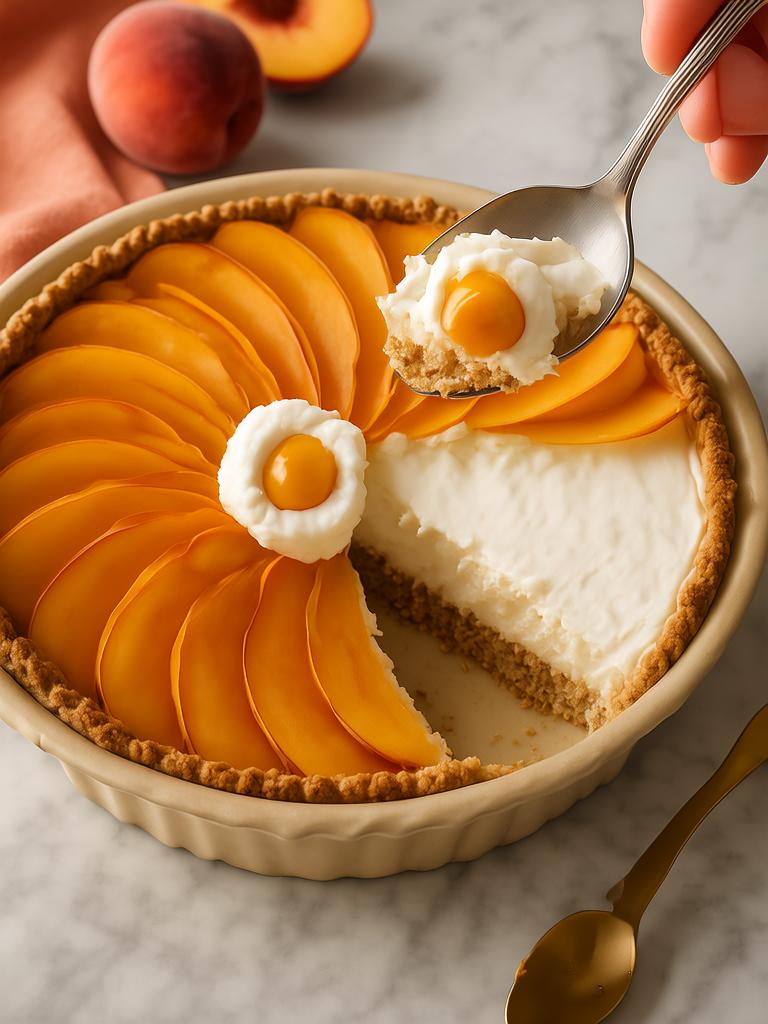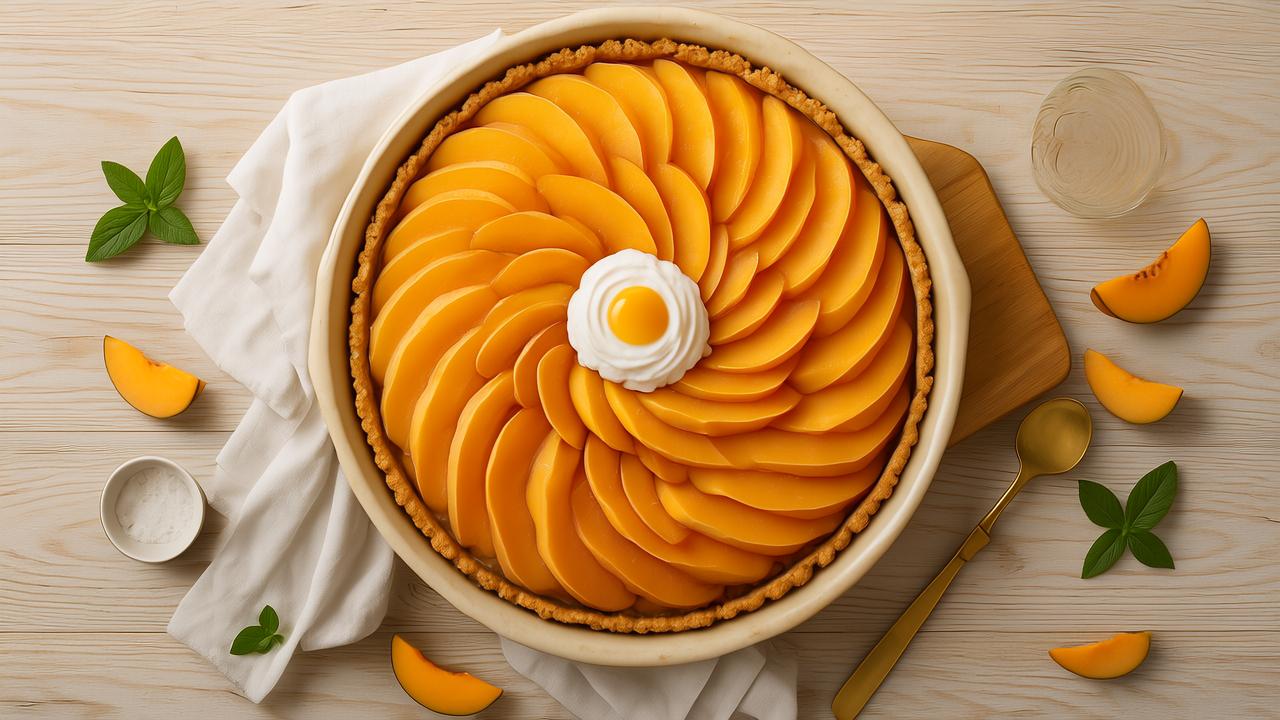There’s something wild about biting into a dessert that never saw the inside of an oven. It feels almost rebellious. No-bake peaches & cream pie is one of those deceptively simple creations that teases the palate with a cool, rich bite—velvety cream and fresh peaches dancing in perfect sync. And yet, beneath that easy charm lies a surprising complexity that professional cooks should never overlook.
This article dives deep—not just into the how, but the why—behind crafting the perfect no-bake peaches & cream pie. If you’re in the culinary game, you already know: nothing “easy” is ever as easy as it seems when excellence is the bar.
The Allure of No-Bake Desserts in a Professional Kitchen
No-bake desserts are not lazy. Let’s get that clear upfront.
In professional kitchens, especially in summer, no-bake options aren’t just convenient—they’re strategic. You don’t overheat the kitchen. You reduce oven rotation during rush hours. You also give yourself a way to offer fresh, light, fruit-forward dishes without compromising on texture or structure.
According to Technomic’s 2024 Dessert Consumer Trend Report, 52% of diners prefer chilled fruit desserts in warmer seasons, with peach-based dishes growing in popularity among 18–34-year-olds. That’s not nothing.
And peaches, ripe and messy and just barely holding it together—well, they bring more than sweetness. They bring nostalgia. They bring Southern summer vibes. And that sells.
Core Components That Make or Break This Pie
Any good pastry chef will tell you: structure is sacred.
No-bake pies, however, laugh in the face of structure. You’re essentially layering wet-on-wet, soft-on-soft—unless you know what you’re doing. That’s why every element needs balance and intent.
Crust: More Than a Graham Cracker Afterthought
Let’s talk crust.
Most home cooks toss graham cracker crumbs with melted butter and pat it in the dish. But pros? They know this crust carries the pie.
Use fine, evenly ground graham crumbs. Add a bit of brown sugar for depth—maybe a pinch of salt if you’re bold. And when mixing the butter, go slow. Over-saturating leads to sogginess, and under-saturating? Crumble city.
Pro move: Toast the crumbs lightly in a dry pan before mixing. It deepens the flavor without the oven, and that little trick alone’ll make pastry chefs nod in approval.
Filling: Not Just Whipped Cream and Hope
The cream layer—this is where most amateurs lose the plot.
You need a stable whipped base that holds its shape, even when the pie sits out for a bit. You also want that lush mouthfeel, not something that collapses into air or curdles under peach juice.
Use a combo of heavy whipping cream and softened cream cheese. That second part is key. It anchors the filling. You whip the cream till soft peaks, then gently fold it into a sweetened cream cheese mixture. Vanilla extract adds a roundness that feels nostalgic. A bit of lemon zest? That’s your sleeper agent.
You’d be shocked how many no-bake pies never see a lick of citrus. And it’s criminal, really.

Peaches: Don’t Just Dump and Pray
Fresh peaches can be slippery to work with—literally and figuratively.
The ideal peach? Slightly firm, not mushy. Sweet but still with some acid. If they’re too ripe, they bleed and turn your filling into soup. If they’re under-ripe, well, you might as well be chewing carrots.
Pro trick: Slice peaches thin and toss gently with a bit of honey, lemon juice, and a tiny pinch of cinnamon. Let ‘em sit for 10–15 minutes. That short maceration coaxes out flavor without turning them to mush.
Avoid canned peaches unless absolutely necessary. If you must? Pat them dry. Twice.
Techniques That Separate Good from Great
Here’s the thing—execution makes or breaks this pie.
Chill Time Is Non-Negotiable
You have to give the pie at least 6 hours to chill. Overnight is best.
That time allows the filling to firm up, the crust to hold its shape, and the flavors to mingle like old friends at a summer cookout. If you cut too early, everything slides.
Some pros add a little unflavored gelatin to the cream base for added insurance. It’s subtle but brilliant if you’re prepping for a catered event or wedding buffet. Stability matters when people are Instagramming their food before eating it.
Layering Like a Pastry Architect
You want distinct, clean layers.
Press the crust evenly but not too tightly—it should hold, but not become a concrete slab. The cream should be smooth, no lumps. Spread it with an offset spatula for that satisfying bakery finish.
Top with peaches just before serving if possible. That preserves their color and shape. Want to go extra? Glaze them with a thin apricot jam wash for shine. It’s an old-school pastry move that still dazzles.
Variations for Creative Menus
Once you nail the classic, variations are endless.
- Bourbon Peach Cream Pie: Add 1–2 tablespoons of bourbon to the peach topping. The oak notes pair surprisingly well with graham and cream.
- Lavender-Honey Peaches & Cream Pie: Infuse the cream with culinary lavender and drizzle with floral honey. Great for upscale farm-to-table concepts.
- Peach Mango Tropical Twist: Layer fresh mango slices alongside peaches. Add a squeeze of lime to the whipped filling for a beachy twist.
Troubleshooting: Common Pitfalls in the Pro Kitchen
Even seasoned chefs slip sometimes. Here’s where things often go sideways.
Crust Too Crumbly?
Not enough butter or not pressed firmly enough. Try adding an extra tablespoon next time and use the back of a spoon to press it evenly.
Filling Weeping or Too Soft?
Could be over-whipping or under-chilling. Or too-wet peaches sinking through the cream. Gelatin can help, but better technique is always the answer.
Peaches Browning?
You waited too long after slicing. Always toss in lemon juice, and don’t refrigerate uncovered—they oxidize fast.
The Science of Texture: Why This Works
Here’s where it gets nerdy—in a good way.
Cream cheese stabilizes the whipped cream by acting as an emulsifier. It prevents over-whipped collapse and gives a denser bite, which is exactly what you want in a no-bake pie. Peaches, with their high water content, need to be placed carefully. That’s why we slice and rest them—it lets them shed some water before meeting the cream.
And that crust? The butter solidifies in the fridge, locking the crumb structure. Science and taste—best friends, always.
Sustainability and Sourcing Insights
For high-end kitchens and eco-conscious menus, sourcing matters.
Peaches are usually in peak season June through August in the U.S. For optimal flavor and sustainability, source from local orchards or farmer’s markets. The fewer miles your peach has traveled, the better it tastes.
Opt for organic dairy if you’re building a cleaner menu. And compost your peach skins—they break down beautifully.
According to USDA data, nearly 40% of commercial food waste comes from improperly stored fruit. Training your staff to understand peak ripeness and storage can save you hundreds over the season.
Answering the Critics: Isn’t This Too Simple?
Simple isn’t the same as easy.
Creating a showstopper without baking requires intention. Precision. Restraint. Anyone can dump whipped topping on a crust. But real cooks? They coax texture, balance acid and fat, make each bite feel deliberate.
Gordon Ramsay once said that making a brilliant simple dish is harder than doing fancy. No-bake pies prove that point every time.
Final Thoughts: Why This Pie Deserves a Place on Your Menu
No-bake peaches & cream pie isn’t just a summer filler. It’s a celebration of good ingredients, expert restraint, and chill confidence. When done right, it delivers both nostalgia and elegance—a rare combo.
So whether you’re plating it in a fine dining spot, offering it as a light dessert on a bistro menu, or serving up slices at a catered rooftop brunch—don’t underestimate it.
Take the time. Pick the right peaches. Whip the cream like it owes you rent. And build a dessert that whispers cool perfection, even when the sun’s threatening to melt your patience.
It’s not just dessert. It’s technique wearing a sundress.
FAQs
What is a no-bake peaches & cream pie?
It’s a chilled dessert made with a graham cracker crust, creamy filling, and fresh peach topping—no oven needed.
Can I use canned peaches instead of fresh?
Yes, but fresh peaches are preferred for better texture and flavor—just pat canned ones dry.
How long should the pie chill before serving?
At least 6 hours, though overnight is ideal for best structure and flavor.
What stabilizes the cream filling?
Softened cream cheese helps stabilize the whipped cream and gives it a richer texture.
How do I prevent the peaches from browning?
Toss them in lemon juice and add just before serving to keep them vibrant.
Can I add gelatin to the filling?
Yes, unflavored gelatin adds extra firmness, especially helpful for events or hot days.
Is this pie freezer-friendly?
Not recommended—the texture changes and the peaches may become watery.
How long does it last in the fridge?
Up to 3 days if covered well, though best enjoyed within 24–48 hours.
Can I make this gluten-free?
Absolutely—just use gluten-free graham crackers for the crust.
What’s the best peach variety to use?
Yellow freestone peaches work best—they’re flavorful and easy to slice cleanly.

Mariana is a passionate home cook who creates delicious, easy-to-follow recipes for busy people. From energizing breakfasts to satisfying dinners and indulgent desserts, her dishes are designed to fuel both your body and hustle.
When she’s not in the kitchen, she’s exploring new flavors and dreaming up her next recipe to share with the Foodie Hustle community.

